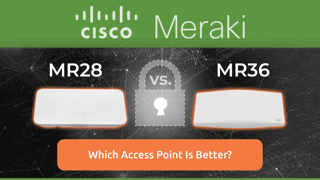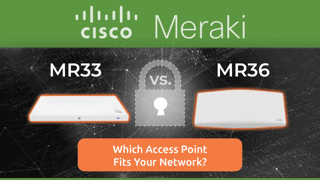Meraki Subscription Licensing: What You Need to Know
Table of Contents
- Why Licensing Matters In A Cloud-Managed World
- Comparing Meraki Licensing Tiers and Subscription Features
- Licensing Tiers and Subscription Options
- Activating and Scaling Your License Subscriptions
- Managing Expirations and License Renewals
- What Influences Pricing and Cost Planning?
- Leading IT Teams Choose Hummingbird Networks for Meraki Licensing
- Maximize Uptime and Efficiency with Smart Licensing
- FAQs
Every Meraki access point, switch, firewall, or camera requires active Meraki subscription licensing before the Dashboard will allow you to click Save. That key also provides firmware, security intelligence, and 24/7 support. Let it lapse and, after a short grace period, traffic stops.
This guide discusses today’s three Meraki subscription licensing models and outlines a sensible renewal rhythm that keeps both your network and finance teams at ease.
Why Licensing Matters In A Cloud-Managed World
Cloud-first networks replace command-line gymnastics with continuous, centralized management. The trade-off is simple:
Control lives in the cloud: No license means no Dashboard, which means no config changes.
Security relies on live feeds: Threat intelligence, IDS/IPS, and content filtering pull hourly updates that require an active key.
Budgets stay predictable: Knowing exact renewal dates enables IT to schedule hardware swaps and prevent unexpected downtime.
As more companies integrate branch connectivity and security into the Meraki stack, Meraki subscription licensing discipline transitions from a paperwork-based approach to a core availability requirement.
Comparing Meraki Licensing Tiers and Subscription Features
Three different frameworks now sit under the Meraki umbrella. Each one changes how you budget, mix feature sets, and recover from an expired key.
Co-Termination Licensing
All license days roll into a single organization-wide date that recalculates each time you add or remove a key. Admins love the simplicity; auditors, however, hate the single point of failure—miss that one anniversary, and the entire estate enters a 30-day grace countdown.
Subscription Licensing
Cisco’s newest model (MERAKI-SUB or CISCO-NETWORK-SUB) is hardware-agnostic. One subscription can cover multiple switches today and brand-new models tomorrow without a license swap, which is ideal for organizations that refresh gear mid-term.
Licensing Tiers and Subscription Options
Cisco Meraki offers three feature bundles that stack on top of one another. The right choice depends on how much security intelligence and WAN optimization your sites need today, and how much headroom you want for tomorrow’s upgrades.
Enterprise
The entry tier covers the essentials that make Meraki famous:
Cloud dashboard access for every switch, AP, and firewall
Layer 2/Layer three routing with VLANs, DHCP, and static routes
Client analytics that surface usage, device type, and application breakdowns
Zero-touch provisioning so branch gear boots, phones home, and pulls its config without a site visit
Choose Enterprise when the priority is reliable connectivity and central management, rather than in-depth security inspection. It’s the default pick for guest Wi-Fi, basic branch offices, and labs.
Advanced Security
Add-on security features sit on top of everything in Enterprise:
Stateful firewall + application-level policies to block risky traffic
Threat-intelligence-fed IDS/IPS using Snort signatures updated hourly
Content and URL filtering with customizable block/allow lists
Cisco Umbrella Secure Internet Gateway (SIG) integration for cloud-based DNS security
Advanced Security targets retail, healthcare, and any environment bound by PCI-DSS, HIPAA, or cyber-insurance mandates that demand active threat defense.
SD-WAN Plus
The flagship package layers intelligent WAN and performance analytics onto Advanced Security:
Dynamic path selection that measures latency, jitter, and loss, then auto-steers traffic down the best circuit
Policy-based SaaS breakout to send Microsoft 365, Zoom, or Salesforce directly to the internet instead of hair-pinning through HQ
Adaptive VPN mesh with per-flow QoS, packet-loss recovery, and bandwidth forecasting
Deep web-app analytics that pinpoint whether slow Teams calls are a LAN, WAN, or SaaS issue
SD-WAN Plus is designed for multi-site organizations seeking rock-solid voice, video, and cloud app performance while maintaining existing security controls.
Activating and Scaling Your License Subscriptions
A license isn’t active until the Dashboard sees its 14-digit key. The process is painless, yet easy to mis-click when a renewal deadline looms.
Go to Organization › License Info › Add licenses.
Paste the order number or key.
Choose ‘Renew my term’ (extends time) or ‘Add more devices’ (adds capacity).
Review the new expiration dates, then confirm.
Available Term Lengths
Term | Typical Use-Case | Annualised Saving vs 1 yr |
1 year | Short projects, OPEX-friendly | — |
3 years | Standard for most SMB refresh cycles | ~15 % |
5 years | Matches hardware depreciation | ~25 % |
7–10 years | Campus/core investments | 30 % + |
Longer-term contracts freeze pricing but demand the full cash up-front. Loop finance in early.
Managing Expirations and License Renewals
Meraki sends countdown banners at 90, 30, 14, 7, and 1 day before the event. At zero, the 30-day grace clock starts. Ignore that and:
Co-term orgs: Every device stops forwarding traffic.
PDL organizations: only the out-of-license devices shut down.
Subscription organizations: networks bound to the inactive sub go dark.
Missing a single key can take a hospital Wi-Fi network or retail POS offline, so plan renewals like any other maintenance window.
Renewal Best Practices
Treat Dashboard alerts as tickets, not polite reminders.
Enable auto-renewal notifications for extra email nudges.
Align license anniversaries with hardware refresh cycles to ensure optimal maintenance and support.
Maintain a single master spreadsheet (SKU, term, PO, expiry) that everyone updates.
Offload grunt work to a certified MSP; Hummingbird Networks’ team does this all day, every day.
What Influences Pricing and Cost Planning?
Four variables shape your quote: tier, term, device class, and device count. Here’s a speed run of the major product families:
MR Wi-Fi – license per access point (Enterprise or Advanced Security).
MS Switches – license per switch; tier follows the AP choice.
MX / vMX Security & SD-WAN – three tiers (Enterprise, Adv Sec, SD-WAN Plus).
MV Cameras – flat license that covers cloud storage and analytics.
MG Cellular & MT Sensors – low-cost cloud-only keys.
Budget Review: Compare your renewal quote with the upcoming hardware swap. Extending a five-year-old switch for one more year is fine, but renewing it for another five probably isn’t.
Leading IT Teams Choose Hummingbird Networks for Meraki Licensing
Why gamble on grey-market keys or chase multiple distributors? Hummingbird Networks is a Cisco Meraki-certified partner that pairs fast quotes with real human support. We’ll map the cleanest move, whether that’s migrating from co-term to PDL or rolling the new subscription SKU, and hand you a single, no-surprises renewal schedule.
Maximize Uptime and Efficiency with Smart Licensing
Licensing doesn’t have to be a fire drill. Select the model that matches your growth plan, calendar the renewals, and let the Meraki cloud handle the heavy lifting.
Unsure which Meraki license fits your deployment? Hummingbird Networks can evaluate your options, simplify renewal planning, and unlock exclusive partner discounts. You can also explore your options in this selection.
FAQs
How do Meraki license renewals work?
You add a new key in the Dashboard › Organization › License Info panel and choose whether to extend your term or add device capacity. Renewal alerts are sent at 90, 30, 14, 7, and 1 day before expiry.
Does every Meraki device need a license?
Yes. Every Meraki device (APs, switches, firewalls, cameras, cellular gateways, and sensors) requires an active license to function in the Dashboard.





